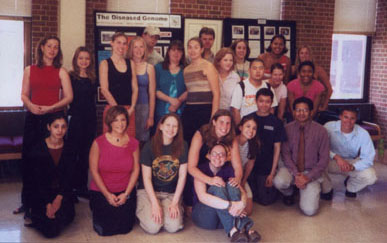 |
| Sitting: Nijee Sharma04, Jillian Argiris04, Rachel Gratis04, Celeste Plautz04, Angie Eakley03 (Peer Teacher), Lisa Yee04, Ryan Inton04, Shubhik DebBurman (Instructor), Spencer Peoples03 Standing: Erin Lynch04, Oksana Nudelman04, Meryl Biksacky04, Leigh Ann Furgeson04,Karl Borchers04, Jennifer Nemeth04, Anna Sienkewicz04, Sean Spurlock03,Laura Beth Gardzelewski04, Samantha England04, Roger Yee, Anne Nitzkowksi03,Tangara Cross04, DâAnne Duncan04, Lee Gross04 |
Student Symposium
This next project is intended to help students develop requisite skills in orally presenting their review of a specific topic based on integrating information from several related primary articles. To achieve this, I ask the groups to role-play the same team of disease experts now invited to present a joint 45-minute research seminar at a public research symposium entitled the The Diseased Genome. This course capstone project is held towards the semester's end during laboratory sessions. Depending on enrollment and number of laboratory sessions, the symposium is usually all day long or progresses over two weekdays. Up to four talks are presented in each session. I purposefully maintain low profile during the symposium so students feel strong ownership of their conference. Posters advertise the symposium around the campus community inviting all to attend (see photo). Many students invite friends and even families to their scientific meeting. Peer teachers serve as the symposium organizers and panel chairs. All student speakers are presented with copies of the TIDS journal. The Abstracts Book is distributed to all symposium attendees.
To
make the symposium setting as real as possible, student presenters dress
in professional attire and a celebratory reception is held at the symposium
end. Talks are videotaped and made available to students for later self-review.
Students typically present a 45-minute PowerPoint seminar, but they are
strongly encouraged to supplement it with other audio-visual support. In
the past, students have used overheads, chalk-and-board, or have performed
theatrical skits depicting either a research lab setting, patients in a
doctor's office, or how biological molecules interact in a signaling pathway.
Others have created physical props (for example, French bread to represent
a protein and bread knives to represent proteases) and audience-interactive
exercises. One group even engaged the audience in a Jeorpardy-like game
show in which the audience ended up summarizing the main points of the
presentation via a quiz-highly effective! Few creative boundaries are set
except to require that presentation aids must educate peers on a cell biology
concept.